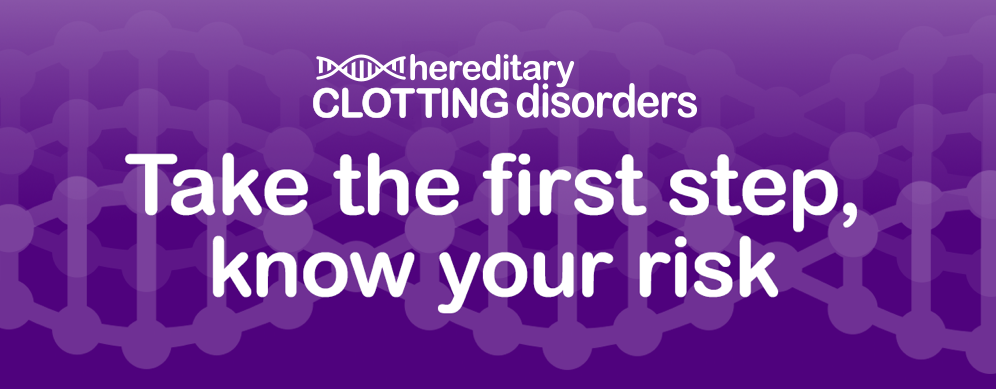Did you know some blood-clotting disorders are inherited?
Some blood-clotting disorders are passed down from your parents. You may never know if you have one of these conditions until you develop a blood clot or another serious complication. If one of the rare genetic clotting disorders below runs in your family, it is important to get tested to find out if you have it, too.
How are inherited blood-clotting disorders diagnosed?
Healthcare providers diagnose inherited blood-clotting disorders with a test called a thrombophilia panel. This test can help determine whether you have hereditary antithrombin deficiency or another inherited blood-clotting disorder, like factor V Leiden, or protein C or protein S deficiency. Based upon your diagnosis, your doctor can provide guidance on how to manage and treat your condition.


Hereditary antithrombin (AT) deficiency is a rare clotting disorder that increases an individual's risk of developing blood clots, most commonly deep vein thrombosis (DVT). A DVT can travel through the bloodstream and lodge in the lungs, causing a life-threatening blockage of blood flow known as a pulmonary embolism (PE).1
It is estimated that approximately 1 in 500 to 5000 people have hereditary antithrombin deficiency. Approximately 50% of individuals with hereditary AT deficiency will develop at least one clot in their lifetime (usually after adolescence). More than 85% of patients with hereditary AT deficiency have suffered at least 1 thrombotic episode by age 50. 1,2
If you have hereditary AT deficiency, you may be at increased risk of developing a clot with surgery, increasing age, lack of movement, and use of oral contraceptives. Women with hereditary AT deficiency who are pregnant or have recently given birth are also at a higher risk for developing a clot.1
Learn more about hereditary antithrombin deficiency.*
Among the people who have experienced an abnormal blood clot, only about 1 in 20 to 200 have been diagnosed with hereditary AT deficiency. Generally low blood levels of antithrombin suggest that you may have antithrombin deficiency. However, it is important to keep in mind that other conditions can lower antithrombin levels (acute clots, heparin therapy, liver or kidney disease, etc.). Repeat testing should be done in order to confirm your diagnosis. If you are not diagnosed with hereditary AT deficiency but have experienced an abnormal blood clot, you may have another inherited blood-clotting disorder.1

Factor V Leiden is a genetic disorder that impacts how the body forms blood clots after an injury, making it more likely for you to develop a blood clot sometime during your life. However, approximately 95% of people with factor V Leiden will never develop a clot. For those who do develop a clot, the first one usually occurs after age 30. The most common clot associated with factor V Leiden thrombophilia is a DVT that occurs in the legs.3

Protein C deficiency is clotting disorder that increases the risk of developing abnormal blood clots, and occurs in mild to severe forms. With mild protein C deficiency, DVT occurs in the arms or legs, which can lead to a pulmonary embolism (PE). In cases of severe protein C deficiency, infants develop purpura fulminans, a life-threatening blood clotting disorder. Soon after birth, infants with purpura fulminans develop blood clots in the small blood vessels throughout their body that block normal blood-clotting flow.4

Protein S deficiency is a disorder that causes abnormal blood clotting. Protein S is an important protein needed for the blood to clot properly. When protein S is missing, or deficient, blood is not able to clot normally, which increases the risk of a thrombosis forming. There are 2 types of protein S deficiency: hereditary and acquired. Some individuals with hereditary protein S deficiency may develop purpura fulminans. Acquired protein S deficiency is rare, and is usually caused by another condition such as liver disease or vitamin K deficiency.5
Talk with your doctor about getting tested
If one of these genetic clotting disorders is diagnosed, it can be treated. However, genetic clotting disorders are often undiagnosed and untreated, which can lead to serious complications. This is why testing for a clotting disorder is so important.
A blood test is the only way to find out if you have one of these serious hereditary conditions. If someone in your family has one of these rare genetic disorders, don't wait—talk with your doctor about getting tested today.
To learn more about genetic blood-clotting disorders, please visit the National Blood Clot Alliance at stoptheclot.org
* These websites are provided as a resource only and do not constitute an endorsement by Grifols of any particular content. Grifols does not review or control the content of non-Grifols websites.
References
- Hereditary antithrombin deficiency. National Institutes of Health website. https://rarediseases.info.nih.gov/diseases/6148/hereditary-antithrombin-deficiency. Accessed February 22, 2023.
- Kottke-Marchant K, Duncan A. Arch Pathol Lab Med. 2002;126:1326-1336.
- Factor V Leiden thrombophilia. National Institutes of Health website. https://rarediseases.info.nih.gov/diseases/6403/factor-v-leiden-thrombophilia. Accessed February 22, 2023.
- Protein C deficiency. National Institutes of Health website. https://ghr.nlm.nih.gov/condition/protein-c-deficiency. Accessed February 22, 2023.
- Protein S deficiency. National Institutes of Health website. https://rarediseases.info.nih.gov/diseases/4524/protein-s-deficiency. Accessed February 22, 2023.


